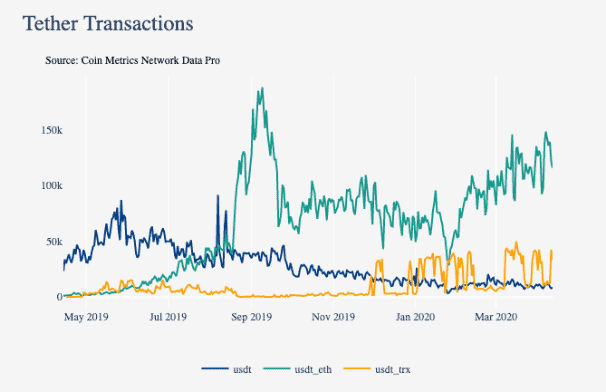Stablecoin markets have had some of the highest trading volumes in the past month, as the crypto community witnessed an influx of traders entering USDT markets after the market crash on 13 March.
The importance of Stablecoins has never been in question since its introduction back on October 6th, 2014. Over the years, other stable assets have entered the space as well such as USDC coin, PAX and Binance’s recent BUSD coin. However, the dominance of Tether in the stablecoin market is fairly evident and USDT continues to be the top-most traded stable asset.
According to data, after an unceremonious decline on 13 March, bitcoin trading in USDT had tripled in March, surge by more than 180 percent in a month. The same scenario was observed with the US dollar and the Japanese Yen, both trading BTC 2.7 million and BTC 1.8 million.
However, the main tussle for dominance was going on somewhere else. Ryan Sean Adam’s recent post suggested that a stablecoin flipping has been unfolding over the past year, and Ethereum could slowly overtake the reigns as USDT settled on the ETH network that currently holds the monopoly over Bitcoin’s Omni.
Coinmetrics illustrates the superiority of Ethereum issued Tether
According to Coinmetrics recent weekly analysis, it was reported that Ethereum-issued Tether has continued to climb the ladder in terms of utilization. On April 7th, the USDT-ETH registered daily transactions of 143.32k, the highest total since September 2019. The number of USDT_ETH daily transactions also overtook the number of daily transactions witnessed on 13th March, the aftermath of the market crash.
The chart below clearly identifies the high USDT_ETH dominance over Omni Tether (USDT) and Tron-Tether (USDT-TRX) which continued to incur less daily transactions on a regular basis.

Now, the report suggested that the growth of ETH USD also manifested certain changes in the exchanges. According to data, the total number of Bitcoin held by Bitfinex has been on a downward spiral since April 2nd and BTC Supply has continued to decline by 24 percent over the last month. A similar situation has been observed in BitMEX with a 26 percent decline in BTC supply.

On the other hand, the accumulation of Ethereum on Bitfinex has undergone a significant increase of 13 percent in the past 30 days, which according to the report, “is a larger percentage increase than any other exchange in our coverage”.
What does it mean for Ethereum in the long-term?
Ryan Sean Adams’ post highlighted another key aspect. For Ethereum the implication of this data can be immense. For starters with DeFi’s growth, Ethereum has already allowed these stablecoin users to access these DeFi apps, which in the next few years could go on to become a massive open finance space.
His report added,
“While it’s possible another network could surpass Ethereum on stablecoin issuance, it’s unlikely that crypto banks will issue on anything other than a credibly neutral platform—that’s why we’re unlikely to see USDC on Binance chain or Tether on a chain controlled by Coinbase.”
At the time of writing this article, a total of 75 percent of the stablecoins presented in the current market were settled on Ethereum.

